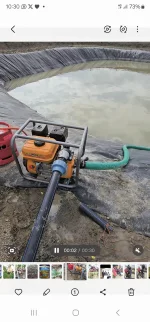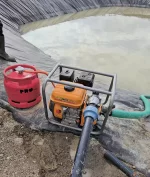kenthefarmer
Lister
Choosing the right water pump is a key step in setting up an efficient irrigation system. A good pump ensures water is delivered effectively and reduces operational costs. Whether you’re a new farmer or upgrading your system, here’s a guide to selecting the ideal pump for your needs.
1. Understand Your Water Source
Your water source plays a major role in determining the type of pump you’ll need:
Shallow Wells or Rivers: Surface pumps are best for water sources less than 7 meters deep.
Deep Wells: Submersible pumps are ideal for water sources deeper than 7 meters.
Overhead Tanks or Water Ponds: Booster pumps can increase water pressure in your system.

2. Evaluate the Pump’s Power (Horsepower)
a. High-Powered Pumps for Large Farms
On my farm, I use a 33hp Jiang Dong (JD), delivering 140m³/hr. It works perfectly with my permanent water source (a river).
Ranging from 180,000ksh -230,000ksh

Best for: Large farms needing significant water volumes and where abundant water is available.
Other Pumps includes lister 16-24Hp ranging from. 120,000-160,000ksh
b. Smaller Diesel Pumps for Nearby Farms
If your farm is closer to the water source, consider a 7hp, 14hp, or 16hp lifter pump.
Flow Rate: Capable of lifting water efficiently for small to medium farms.

Price Range: 60,000–80,000 Ksh.
Note: Regular servicing is essential to maintain efficiency.

c. Petrol Pumps for Flat Lands
For flat lands, a 4hp petrol pump is a great choice. These are affordable, lightweight, and versatile:
High-Pressure Machines: Deliver strong water pressure, ideal for sprinklers or irrigating crops over long distances.
Low-Pressure Machines: Suitable for simple irrigation systems with minimal water pressure needs.
Price Range: 19,000–35,000 Ksh, depending on the brand and model.
Additional Tip: You can later convert these pumps to LPG (gas), reducing fuel costs and making them more eco-friendly.

3. Know the Pump’s Flow Rate
Flow rate determines how much water your pump delivers:
Amount of water a pump can deliver per hour.
4. Understand the Pump Head Height
Pump head height refers to the vertical and horizontal distance the water needs to travel:
Vertical Lift: The height from the water source to the pump.Also refered to as sunction head.
Discharge Height: The height from the pump to the irrigation system.
5. Match the Pump to Your Irrigation System
The type of irrigation system you have also influences your pump choice:
Drip Irrigation: Requires a pump with consistent, low-pressure water flow.
Sprinklers: Need high-pressure pumps to distribute water evenly.
6. Choose the Right Fuel or Power Source
Diesel Pumps: Durable, ideal for remote large scale farms.
Petrol Pumps: Lightweight and versatile, great for small-scale farms or flat lands.
Electric Pumps: Best for areas with reliable electricity supply.
Solar Pumps: A long-term, eco-friendly solution for sunny regions.
7. Consider Durability and Maintenance
Choose a pump built to last in tough farming conditions. Ensure that spare parts are readily available and the pump is easy to maintain.
8. Seek Professional Advice
If unsure, consult irrigation experts like our company to choose a pump suited to your farm’s unique needs.
~village investor
1. Understand Your Water Source
Your water source plays a major role in determining the type of pump you’ll need:
Shallow Wells or Rivers: Surface pumps are best for water sources less than 7 meters deep.
Deep Wells: Submersible pumps are ideal for water sources deeper than 7 meters.
Overhead Tanks or Water Ponds: Booster pumps can increase water pressure in your system.
2. Evaluate the Pump’s Power (Horsepower)
a. High-Powered Pumps for Large Farms
On my farm, I use a 33hp Jiang Dong (JD), delivering 140m³/hr. It works perfectly with my permanent water source (a river).
Ranging from 180,000ksh -230,000ksh
Best for: Large farms needing significant water volumes and where abundant water is available.
Other Pumps includes lister 16-24Hp ranging from. 120,000-160,000ksh
b. Smaller Diesel Pumps for Nearby Farms
If your farm is closer to the water source, consider a 7hp, 14hp, or 16hp lifter pump.
Flow Rate: Capable of lifting water efficiently for small to medium farms.
Price Range: 60,000–80,000 Ksh.
Note: Regular servicing is essential to maintain efficiency.
c. Petrol Pumps for Flat Lands
For flat lands, a 4hp petrol pump is a great choice. These are affordable, lightweight, and versatile:
High-Pressure Machines: Deliver strong water pressure, ideal for sprinklers or irrigating crops over long distances.
Low-Pressure Machines: Suitable for simple irrigation systems with minimal water pressure needs.
Price Range: 19,000–35,000 Ksh, depending on the brand and model.
Additional Tip: You can later convert these pumps to LPG (gas), reducing fuel costs and making them more eco-friendly.
3. Know the Pump’s Flow Rate
Flow rate determines how much water your pump delivers:
Amount of water a pump can deliver per hour.
4. Understand the Pump Head Height
Pump head height refers to the vertical and horizontal distance the water needs to travel:
Vertical Lift: The height from the water source to the pump.Also refered to as sunction head.
Discharge Height: The height from the pump to the irrigation system.
5. Match the Pump to Your Irrigation System
The type of irrigation system you have also influences your pump choice:
Drip Irrigation: Requires a pump with consistent, low-pressure water flow.
Sprinklers: Need high-pressure pumps to distribute water evenly.
6. Choose the Right Fuel or Power Source
Diesel Pumps: Durable, ideal for remote large scale farms.
Petrol Pumps: Lightweight and versatile, great for small-scale farms or flat lands.
Electric Pumps: Best for areas with reliable electricity supply.
Solar Pumps: A long-term, eco-friendly solution for sunny regions.
7. Consider Durability and Maintenance
Choose a pump built to last in tough farming conditions. Ensure that spare parts are readily available and the pump is easy to maintain.
8. Seek Professional Advice
If unsure, consult irrigation experts like our company to choose a pump suited to your farm’s unique needs.
~village investor


